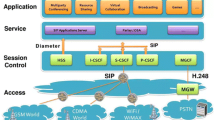Abstract
As universal high speed internet access becomes a reality, phone calls are increasingly being made over the Internet rather than the conventional PSTN. The danger to this trend is the un-availability of priority mechanisms for communication between emergency response personnel during times of disaster. We define a proposed architecture to enable ETS support for SIP-based VOIP systems.
Preview
Unable to display preview. Download preview PDF.
Similar content being viewed by others
References
GETS Government Emergency Telecommunications Support, http://gets.ncs.gov/
RFC3261 Session Initiation Protocol, http://www.ietf.org/rfc/rfc3261.txt
Java Community Process JSR 22: The JAIN Service Logic Execution Environment, http://www.jcp.org/en/jsr/detail?id=22
Communication of Resource Priority for SIP, http://www.ietf.org/internet-drafts/draft-ietf-sip-resource-priority-08.txt
RFC3725 Best practices for 3rd party call control in SIP, http://www.ietf.org/rfc/rfc3725.html
RFC2475 An architecture for Differentiated Services, http://www.ietf.org/rfc/rfc2475.html
The Mobicents open SLEE platform, http://mobicents.dev.java.net/
Author information
Authors and Affiliations
Editor information
Editors and Affiliations
Rights and permissions
Copyright information
© 2005 Springer-Verlag Berlin Heidelberg
About this paper
Cite this paper
Moggia, F., Ranganathan, M., Kim, E., Montgomery, D. (2005). Emergency Telecommunication Support for IP Telephony. In: Magedanz, T., Madeira, E.R.M., Dini, P. (eds) Operations and Management in IP-Based Networks. IPOM 2005. Lecture Notes in Computer Science, vol 3751. Springer, Berlin, Heidelberg. https://doi.org/10.1007/11567486_1
Download citation
DOI: https://doi.org/10.1007/11567486_1
Publisher Name: Springer, Berlin, Heidelberg
Print ISBN: 978-3-540-29356-9
Online ISBN: 978-3-540-32096-8
eBook Packages: Computer ScienceComputer Science (R0)




